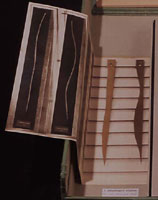|
1a. Three Standard Stoppages
Scholars have already carefully underlined that the operative procedure described by Duchamp for the execution of Three Standard Stoppages (1913-14) (Fig. 1) seems to be unreliable. By means of experimental proofs we have the evidence that it is seemingly "unobtainable," somewhat like Duchamp's Stoppages. Furthermore, an inspection of the work at MoMA (Museum of Modern Art in New York City) shows two tacks at the opposite extremities of the thread on the backside of each canvas. These tacks seem to exclude what the famous note contained in the Green Box, (also entitled The Bride Stripped Bare by Her Bachelors Even, as the project it accompanies), definitively describes. Rhonda R. Shearer and Stephen J. Gould have already thoroughly documented these findings (1999), but even they highlight Duchamp's insistence about the truthfulness of the note when directly and explicitly asked about this subject. In the following paragraph I present some considerations on this topic.
A simple measurement shows that the distance (as a straight line) between the visible extremities of each Stoppage is constant. Indeed, in Tu m' (Fig. 2) (description in a successive paragraph) the Stoppages appear carefully coupled, end against end. However, it is absolutely improbable that three threads, when freely dropped, dispose themselves showing, three consecutive times, the same distance between their extremities. This seems to confirm once more the practical impossibility to obtain the result shown by Duchamp in Three Standard Stoppages according to the instructions contained in the note of the Green Box. However, if Duchamp claims obstinately that he followed that operative protocol, this insistence induces some reflections. His work is intentionally marked with misleading traps and ambiguities; however, Duchamp usually operates in such a manner that our own sense deceives us, not his words per se. His challenge to the observer is fair and correct--the traces are intentionally ambiguous, but they are upfront with the observer in their objectivity--and the cleverness and analytical thinking involved in the interpretation of them is left to the reader. Interestingly, we note that in the Stoppages, Duchamp carefully masked the equality of the lengths (in straight lines) of the three threads and their wooden templates.
So, let us observe Duchamp’s "traps" that occur when the work is vertically displayed (as the orientation of the text labels of each thread suggests). For this aim I shall consider the miniaturized reproduction of Three Standard Stoppages in the Boîte-en-valise (1941) (Fig. 3), where all the six components of the work (3 threads and 3 wooden templates) are surely disposed by Duchamp himself. But similar considerations can be done for all the different dispositions I know, including that at MoMA. The labels, placed
near the bottom side of the canvases, are carefully lined up to each
other, whereas the threads are glued starting from different distances
from the top, which prevents us from comparing at a glance the lengths
and the lining up of the extremities of the threads. One may impute
this displacement to the randomness of each drop of the threads. Remember,
however, that Duchamp cut the canvas strips (where the threads are glued)
after the drop, successively, several years later. Duchamp could pay
the same attention that he paid to the alignment of the labels to the
alignment of the starting points of the threads. He used deceiving techniques
analogous to these thread alignments for the presentation of the three
wood templates. First, the order of the presentation of the threads
(T) is, to say, TA, TB, and TC, whereas
the wooden templates (W) are presented in the order WC, WA,
WB. Second, the templates are rotated by 180° relative to
the corresponding threads, which once more makes the comparison at a
glance difficult. Third, in order to overlap the template on the correspondent
thread, we have to mentally reverse the wooden templates WC
and WA, because their outline shows a mirror symmetry with
respect to the correspondent threads TC and TA,
which presents new difficulties if one is looking for constant landmarks
in the vision. The resulting scheme follows.
Finally in two templates the starting point for the curvilinear outline is marked by a well-visible dent in the wood (and at the same distance from the upper side), whereas in the third one we observe once more a displacement (forward) for the starting point of the curvilinear outline. With this last template it seems that Duchamp wants to give us a little clue: in this case there isn't a dent at the starting point of the curvilinear outline, a dissimilarity that we perceive immediately. We do not know whether these displacements in the composition of the elements are fortuitous. (We know, however, that Duchamp was very scrupulous when planning his works.) If not, we can think that what is so carefully hidden must prove extremely important. In the contrary case, we can at least understand why, so far, scholars haven’t considered the objective datum I discuss here in relation to the new difficulties it introduces for accepting the operative protocol declared by Duchamp for the Stoppages. Hence, however it turns out, the constant distance between the extremities of each thread seems to be a crucial point. >>Next
Figs.
1-3
page 1 2 3 4 5 6 7 8 9 10 11 12 13 14 15 |
||||||||||||||||||||||||||||















